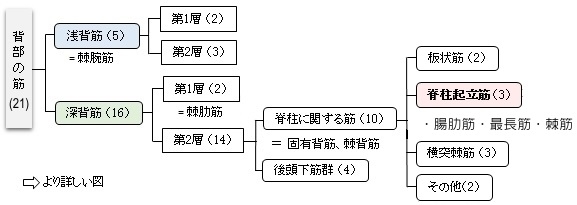脊柱起立筋とは

以下は「日本人体解剖学 (上巻) 」を参考にして作成した「背部の筋」の図になる。
」を参考にして作成した「背部の筋」の図になる。

「船戸和弥のホームページ」では以下のように解説している
「脊柱起立筋は腸肋筋、最長筋および棘筋の総称である。これらの筋は共同して脊柱を反らせ、直立に貢献するので、この名がある。しかしこの名称は機能的観点からの名称にすぎない。形態学的には腸肋筋と最長筋は外側系であるのに対し、棘筋は内側系で別系に属する。」
また、以下が「Wikipedia」の解説文となる。
「The erector spinae (/???r?kt?r ?spa?ni?/ ?-REK-t?r SPEYE-nee)[1] or spinal erectors is a set of muscles that straighten and rotate the back.
The erector spinae is not just one muscle, but a bundle of muscles and tendons. It is paired and runs more or less vertically. It extends throughout the lumbar, thoracic and cervical regions, and lies in the groove to the side of the vertebral column. Erector spinae is covered in the lumbar and thoracic regions by the thoracolumbar fascia, and in the cervical region by the nuchal ligament.
This large muscular and tendinous mass varies in size and structure at different parts of the vertebral column. In the sacral region, it is narrow and pointed, and at its origin chiefly tendinous in structure. In the lumbar region, it is larger, and forms a thick fleshy mass. Further up, it is subdivided into three columns. These gradually diminish in size as they ascend to be inserted into the vertebrae and ribs.
The erector spinae arises from the anterior surface of a broad and thick tendon. It is attached to the medial crest of the sacrum, to the spinous processes of the lumbar and the eleventh and twelfth thoracic vertebrae and the supraspinous ligament, to the back part of the inner lip of the iliac crests, and to the lateral crests of the sacrum, where it blends with the sacrotuberous and posterior sacroiliac ligaments.
Some of its fibers are continuous with the fibers of origin of the gluteus maximus.
The muscular fibers form a large fleshy mass that splits, in the upper lumbar region, into three columns, viz., a lateral (Iliocostalis), an intermediate (Longissimus), and a medial (Spinalis). Each of these consists of three parts, inferior to superior, as follows:」
■ 写真やイラストを掲載しているサイト ■
・ イラストや写真を掲載しているサイト-Ⅰ
・ イラストや写真を掲載しているサイト-Ⅱ
・ イラストや写真を掲載しているサイト-Ⅲ
・ イラストや写真を掲載しているサイト-Ⅳ
【断面図】
・ イラストや写真を掲載しているサイト-Ⅰ
・ イラストや写真を掲載しているサイト-Ⅱ
・ イラストや写真を掲載しているサイト-Ⅲ
・ イラストや写真を掲載しているサイト-Ⅳ